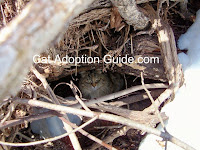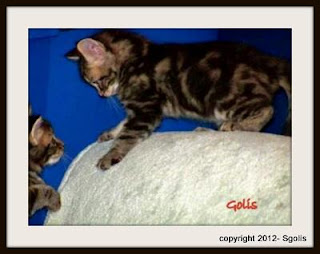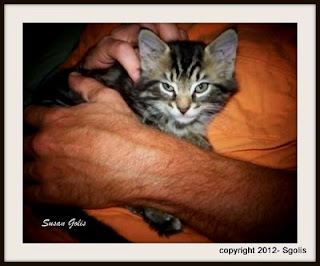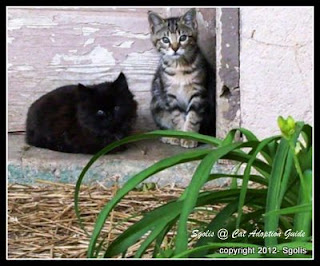If you have adopted a weaned 7 to 8 week old feral kitten then the first day will be difficult however the days will get easier as time goes by. Remember that the kitten is afraid as you have taken them from their comfort zone and you must teach them how to be an indoor cat and live with humans and other pets.
Get Family and Home Ready for New Kitten
Before you bring a feral kitten into your home you will need to have a family meeting.
Gather the family for a meeting to discuss household feral kitten rules. Feral kittens are accustomed to outdoor sounds and household noise will frighten them. Your home must be quiet with no loud noises, or bickering, that means no loud volume on the TV. Feral kittens need homes that are peaceful. During the adjustment period family members and pets cannot enter the safe room where the feral kitten is being kept. Only the person who intends on socializing the kitten must interact with the kitten for 60 days. By doing this the feral kitten will dependent upon you as if you are the mother cat.
Buy a cat crate that is large enough to hold cat bed with cover so kitten can hide, covered litter box, food and water bowls and small scratching post and a hammock. You will also add one of your dirty sweatshirts, one that has your scent on it.
that is large enough to hold cat bed with cover so kitten can hide, covered litter box, food and water bowls and small scratching post and a hammock. You will also add one of your dirty sweatshirts, one that has your scent on it.
Picking up Feral Kitten
Set up the crate before you go to pick up the feral kitten. A small crate or cat carrier is also needed to transport feral kitten to your home. Line the cat cattier with newspapers. If it is cold outside line with a warm fleece or thermal receiving blanket. Feral kittens must be kept warm.
Picking up Feral Kitten
Set up the crate before you go to pick up the feral kitten. A small crate or cat carrier is also needed to transport feral kitten to your home. Line the cat cattier with newspapers. If it is cold outside line with a warm fleece or thermal receiving blanket. Feral kittens must be kept warm.
Take a small crate or carrier and a soft fleece blanket with you when you go to pick up the feral kitten. Do not handle the kitten with your bare hands. If you must put the kitten in the carrier then wear heavy leather work gloves  when handling kitten. Gently grab the kitten by their scruff and lift the kitten gently. Wrap the kitten in a warm fleece blanket and hold the kitten firmly so he cannot escape. Set the kitten in the warm fleece blanket in the crate. Loosen the blanket so the kitten can move around. Close the door and latch it securely. Cover the crate with a blanket. Place the crate behind the driver’s seat in the vehicle, turn off the radio and drive slowly home.
when handling kitten. Gently grab the kitten by their scruff and lift the kitten gently. Wrap the kitten in a warm fleece blanket and hold the kitten firmly so he cannot escape. Set the kitten in the warm fleece blanket in the crate. Loosen the blanket so the kitten can move around. Close the door and latch it securely. Cover the crate with a blanket. Place the crate behind the driver’s seat in the vehicle, turn off the radio and drive slowly home.
Traveling back to your home you may want to talk softly to the kitten. Be consoling to their needs. If you sing, sing softly with a soothing voice. When you arrive home gently lift the kitten in the crate from the car and bring the kitten into the house. Set the kitten in the crate in a safe-room such as a home office, or another small room where the cat will be able to watch you but will not be exposed to excess noise and movement.
Get the safe room ready for the kitten by sitting on the floor and look for things that may harm the kitten. The room that I use to socialize the feral cats is in my garage. The room as a concrete floor, concrete walls, a window a desk, chair and a CD player that is anchored to the wall. There is an overhead ceiling light with a dimmer and two electrical outlets with protective coverings and a lazy boy chair..
Get the safe room ready for the kitten by sitting on the floor and look for things that may harm the kitten. The room that I use to socialize the feral cats is in my garage. The room as a concrete floor, concrete walls, a window a desk, chair and a CD player that is anchored to the wall. There is an overhead ceiling light with a dimmer and two electrical outlets with protective coverings and a lazy boy chair..
Transferring Feral Kitten to Large Crate
I crate train all feral kittens. The crate is their safe room. Out of the six kittens that I have socialized all of them as an adult cat sleep in their crates and play with their toys in their crates.
Wear protective gloves when transferring kitten. - Open the door to the large crate.
- Cut a piece of cardboard that is the same size as the opening of the cat carrier that houses the feral kitten.
- Slowly open the cat carrier door and slide the cardboard in front of the opening, this will prevent the kitten from escaping.
- Move the carrier so that it is flush with the opening of the large crate.
- Slowly remove the cardboard that blocks the cats entrance and the feral kitten will run into the large crate.
- Cover the large crate with a flannel sheet to protect kitten from drafts and to provide comfort. Leave a corner of the crate exposed so the kitten can see you.
- Leave the crate door shut for the first 24 hours. By leaving the door shut the kitten will hide in the covered bed and the crate will become their safe room.
If the kitten should react with aggressive behavior; hiss, snarl, spit, chirp, note that the kitten is defensive because you are causing them great anxiety. The kitten is terrified of you the kitten is telling you "I am scared of you please stay away".
First Day Feral Kitten Socialization
Spend time with your feral kitten by visiting the kitten several times throughout the day. Spend a minimum of 4 hours with the kitten. It is better that the kitten is able to watch you. Place the crate next to your desk so the kitten can take in your scent and see you working.
Sit next to the kitten and tell it a story, make eye contact with the kitten and gently exhale close to the kittens face. Plan activities so that you can spend time with the kitten in the room. Read a book or take a nap in the chair. All time spent with the kitten is good.The kitten is becoming adjusted to your scent and is identifying with you.
Feed the kitten whatever they are accustomed to. You do not want to change the diet as it will upset his stomach and cause the kitten to be ill. Gradually change the kitten's diet over the course of 10 days.
Feed the kitten in the morning and night. I feed at 7 am and 7pm. I do not hold back the food. Provide the kitten with fresh water daily.
Kittens are very messy inside their crate, expect them to knock over their food and their water bowl. Also if the litter box is not covered, the litter will be all over the place.
Tips:
Feed the kitten in the morning and night. I feed at 7 am and 7pm. I do not hold back the food. Provide the kitten with fresh water daily.
Kittens are very messy inside their crate, expect them to knock over their food and their water bowl. Also if the litter box is not covered, the litter will be all over the place.
Tips:
- Play soothing music at a soft volume. Music is a good way to relax the kitten. I play sounds of nature, a babbling brook, birds chirping and such. Forest Sounds: with Soft Rains and Gentle Winds Sounds of Nature
- When you are leaving the room for the day, open the crate door half way. Expect to hear the kitten hiss, or chirp, they many also spit. This is a natural reaction, the kitten is terrified.
- Expect the kitten to run from the crate and attempt to climb your walls or drapes. This is natural and all feral cats and kittens behave like this.
- The kitten will learn that the crate is their safe place. You do not want the kitten to fear the crate. If they are confined they may climb the sides of the crate and they may get hurt.
- Wear heavy gloves to protect your hands when adding or removing things from the cat crate.
- Kittens can not be in a draft and the room needs to be warm. They are use to living outdoors so I usually close off the air conditioning vent so the kitten is comfortable.
- If you do not have a crate, set up a small room for the feral kitten. This room will be the feral kittens safe room forever.












